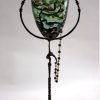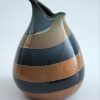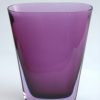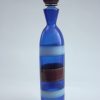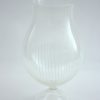FROM THE BEGINNING OF THE CENTURY TO THE FORTIES
Murano glass found its way to innovation in the 1900s when the companies with more acumen began working with artists and designers.
Up until 1920 such meetings were sporadic but productive, as can be seen here by the Art Nouveau bowls on display here by Vittorio Toso Borella (1906-09), the polychrome filament vase by Hans Stoltenberg-Lerche for the Toso brothers, and the small Klimt-style slabs of mosaic glass (1914) by Vittorio Zecchin, produced by the Artisti Barovier glass furnace.
In 1921 a newly founded glassworks, Cappellin & Venini, created the role of ‘artistic director’, appointing none other than Zecchin. This was an absolute novelty for the island and other companies were soon to follow this example; the union between art, design and the unheard of possibilities offered by the technical expertise Murano had to offer thus became a regular feature, with multiple forms of expression, and a succession of people and styles; as can be seen from the many examples on display here, each producer gradually created their own distinct identity.
The works Zecchin produced in the 1920s and 1930s for various glassworks were characterised by the purity, transparency and lightness of the material and shapes; however, in 1925 Cappellin and Venini separated. Zecchin soon made himself independent and the sculptor Napoleone Martinuzzi was appointed artistic director of the Venini until 1931; amongst other things, he invented a new glass that was opaque and thick, ‘pulegoso’ – characterised by the inclusion of countless bubbles of air in it (puleghe) and it was with this that he created original objects of definite plastic character.
The elegant S.A.L.I.R. production reflected the Deco style and here the Bohemian Franz Pelzel engraved decorations by Guido Balsamo Stella. However, it was with growing frequency that artists began working on glass production, for example Guido Cadorin, Alfredo Barbini, Umberto Bellotto (“the magician” of wrought iron), Carlo Scarpa and many others, and these works could be seen at the Biennale and other international exhibitions, where they won prizes and awards.
FROM THE FORTIES TO THE SEVENTIES
Different trends and interests developed in Murano, with particular intensity after the war and with results of outstanding quality.
Heavy glass, also solid, which had started to be considered here at the end of the 1930s, began to develop in a variety of ways in the 1950s/1960s; examples are the polychrome vitreous material of the pieces by Giulio Radi for AVEM, or the ‘submerged’ glass (made of several overlapped transparent layers) that Flavio Poli created for Seguso Vetri d’Arte.
On the other hand, Venini preferred to focus innovatively on traditional techniques, with his blown glass, worked using the ‘flying hand’ (free hand) or the ‘incalmo’ (joining separately worked pieces by heating, to make up a single object) techniques, or engravings, filigree, murrine, etc. The Venini glass factory had been directed by Carlo Scarpa from 1932 to 1947; when Fulvio Bianconi succeeded in 1948, it was at the avant-garde of Murano production.
It continued to create objects of everlasting success, some of which are on display here, collaborating with countless artists and designers that followed over the years, both Italian and foreigners. The Italians included Ludovico de Santillana and his daughter Laura – creators of highly original pieces in the 1960s and 1970s –, Toni Zuccheri and many others; among the foreigners, the Finn Tapio Wirkkala made a particular mark.
Other glass furnaces worked on their own reinterpretation of ancient techniques: Archimede Seguso was specialised in different experiments with filigree and produced, amongst other things, original vertical thread vases, created in a single blow without any other applications; run by the painter Luciano Gaspari from 1965 on, Salviati factory turned its attention to extremely light blown glass, whilst Carlo Moretti devoted his production to tableware and furnishings, creating elegant and uncommonly bold items. It was the quality, the painstaking studies, endless experimentation, fragility and expressive power of these results that made twentieth-century Murano glass a cult object for glass lovers and collectors.





